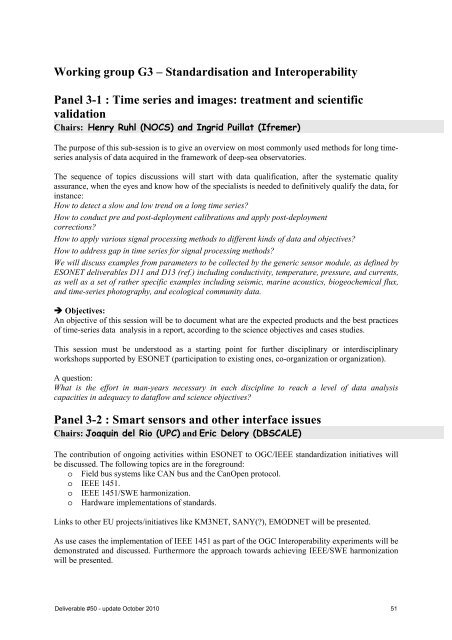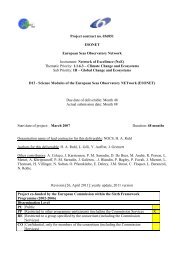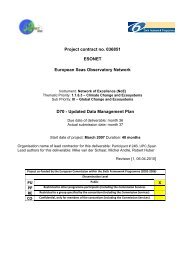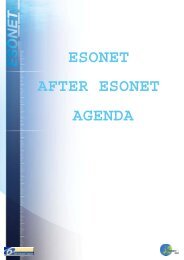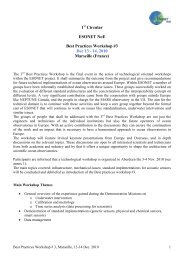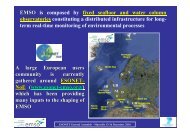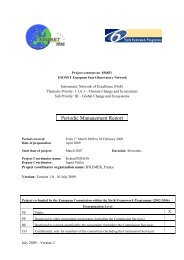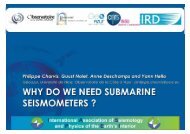Project Deliverable D50 Report on Best Practices ... - ESONET NoE
Project Deliverable D50 Report on Best Practices ... - ESONET NoE
Project Deliverable D50 Report on Best Practices ... - ESONET NoE
Create successful ePaper yourself
Turn your PDF publications into a flip-book with our unique Google optimized e-Paper software.
Working group G3 – Standardisati<strong>on</strong> and Interoperability<br />
Panel 3-1 : Time series and images: treatment and scientific<br />
validati<strong>on</strong><br />
Chairs: Henry Ruhl (NOCS) and Ingrid Puillat (Ifremer)<br />
The purpose of this sub-sessi<strong>on</strong> is to give an overview <strong>on</strong> most comm<strong>on</strong>ly used methods for l<strong>on</strong>g timeseries<br />
analysis of data acquired in the framework of deep-sea observatories.<br />
The sequence of topics discussi<strong>on</strong>s will start with data qualificati<strong>on</strong>, after the systematic quality<br />
assurance, when the eyes and know how of the specialists is needed to definitively qualify the data, for<br />
instance:<br />
How to detect a slow and low trend <strong>on</strong> a l<strong>on</strong>g time series?<br />
How to c<strong>on</strong>duct pre and post-deployment calibrati<strong>on</strong>s and apply post-deployment<br />
correcti<strong>on</strong>s?<br />
How to apply various signal processing methods to different kinds of data and objectives?<br />
How to address gap in time series for signal processing methods?<br />
We will discuss examples from parameters to be collected by the generic sensor module, as defined by<br />
<strong>ESONET</strong> deliverables D11 and D13 (ref.) including c<strong>on</strong>ductivity, temperature, pressure, and currents,<br />
as well as a set of rather specific examples including seismic, marine acoustics, biogeochemical flux,<br />
and time-series photography, and ecological community data.<br />
Objectives:<br />
An objective of this sessi<strong>on</strong> will be to document what are the expected products and the best practices<br />
of time-series data analysis in a report, according to the science objectives and cases studies.<br />
This sessi<strong>on</strong> must be understood as a starting point for further disciplinary or interdisciplinary<br />
workshops supported by <strong>ESONET</strong> (participati<strong>on</strong> to existing <strong>on</strong>es, co-organizati<strong>on</strong> or organizati<strong>on</strong>).<br />
A questi<strong>on</strong>:<br />
What is the effort in man-years necessary in each discipline to reach a level of data analysis<br />
capacities in adequacy to dataflow and science objectives?<br />
Panel 3-2 : Smart sensors and other interface issues<br />
Chairs: Joaquin del Rio (UPC) and Eric Delory (DBSCALE)<br />
The c<strong>on</strong>tributi<strong>on</strong> of <strong>on</strong>going activities within <strong>ESONET</strong> to OGC/IEEE standardizati<strong>on</strong> initiatives will<br />
be discussed. The following topics are in the foreground:<br />
o Field bus systems like CAN bus and the CanOpen protocol.<br />
o IEEE 1451.<br />
o IEEE 1451/SWE harm<strong>on</strong>izati<strong>on</strong>.<br />
o Hardware implementati<strong>on</strong>s of standards.<br />
Links to other EU projects/initiatives like KM3NET, SANY(?), EMODNET will be presented.<br />
As use cases the implementati<strong>on</strong> of IEEE 1451 as part of the OGC Interoperability experiments will be<br />
dem<strong>on</strong>strated and discussed. Furthermore the approach towards achieving IEEE/SWE harm<strong>on</strong>izati<strong>on</strong><br />
will be presented.<br />
<str<strong>on</strong>g>Deliverable</str<strong>on</strong>g> #50 - update October 2010 51


